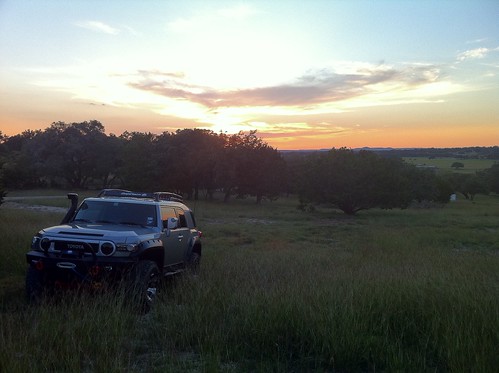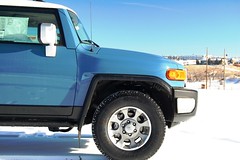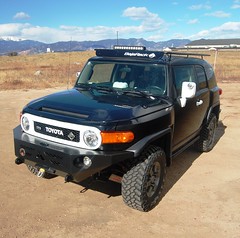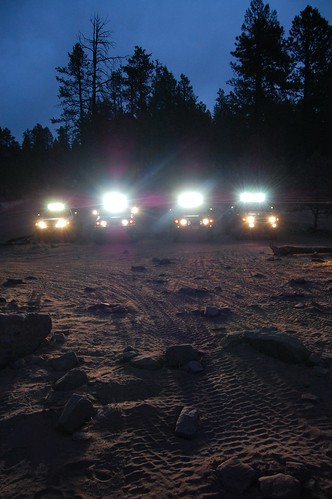April 2011
- Details
- By Doug Wilson
 “Excuse me sir, do you mind if I take a look at your FJ Cruiser?” That was the moment Christi, my wife, told me that she knew I was going to buy an FJ Cruiser.
“Excuse me sir, do you mind if I take a look at your FJ Cruiser?” That was the moment Christi, my wife, told me that she knew I was going to buy an FJ Cruiser.
Acquiring the FJ;
Christi and I had fallen into what so many American’s have over the years: we were severely overweight. The combination of eating poorly, lack of exercise or any strenuous activity in general and both of us working sedative jobs lead to years of slowly getting bigger and bigger.
In December of 2009 we decided it was time to change our lifestyles and start to get healthy again! We started by making better choices for our meals and getting back into exercising. Our choice of exercise was to mountain bike, and boy did the out door fever kick in! We started camping and mountain biking and really enjoying the two. While we where mounting biking at Hidden Falls Adventure Park we noticed a few offroad vehicles and that got us thinking!
- Details
- By Shane Williams
 You’ve seen them on the forums, and you may have seen a 2011 FJ Cruiser at your dealer or on the road. But have you had a chance to sit in one & experience the changes yet? We did just that a few weeks ago when we were able to find a 2011 FJ Cruiser in Calvary Blue at Toyota of Colorado Springs.
You’ve seen them on the forums, and you may have seen a 2011 FJ Cruiser at your dealer or on the road. But have you had a chance to sit in one & experience the changes yet? We did just that a few weeks ago when we were able to find a 2011 FJ Cruiser in Calvary Blue at Toyota of Colorado Springs.
- Details
- By Shane Williams
 As much as we’ve loved our stock roof rack with the WAAG basket insert, that system isn’t compatible with LED light bars. So we got in contact with BajaRack to see if they had something that would work great for a 20” light bar and would give us more clearance for parking garages. They suggested we take a look at their new FJ Cruiser Utility Rack to see if that would fit the bill.
As much as we’ve loved our stock roof rack with the WAAG basket insert, that system isn’t compatible with LED light bars. So we got in contact with BajaRack to see if they had something that would work great for a 20” light bar and would give us more clearance for parking garages. They suggested we take a look at their new FJ Cruiser Utility Rack to see if that would fit the bill.
We’ve come to expect great products from BajaRack and this rack is no exception. It comes very well packaged and includes everything you need to get setup. All hardware is stainless steel and individually packaged, as are all the brackets needed for the install. The rack installs to the stock locations so we won’t go into detail there, the BajaRack instructions are laid out perfectly so there is no guesswork involved.
This rack is perfect for a roof top tent, as a low profile option, or just a great system if you’re constantly hauling items on the roof. Within hours of bolting the rack on I was at Home Depot picking up supplies for a new privacy fence. It handled the load perfectly with its 300lb rated capacity and ample tie down spots. At 51” wide and 91” long, it certainly changes the roofline of the FJ Cruiser, which will take some getting used to. The look is a little more ‘boxy’, but that’s to be expected from a rack like this.
- Details
- By Shane Williams
 Off road lighting has come a long way in the last couple of years. In our original off road light comparison article (January 2009), every light we tested was a traditional halogen type. The main differences in that type of light are the wattage and lens options, since those are the two main factors that effect traditional ‘yellow’ lights.
Off road lighting has come a long way in the last couple of years. In our original off road light comparison article (January 2009), every light we tested was a traditional halogen type. The main differences in that type of light are the wattage and lens options, since those are the two main factors that effect traditional ‘yellow’ lights.
Since then, there have been major advancements in several off road light technologies. High-Intensity Discharge (HID) lights are the current default standard due to their increased light output and decreased power requirements. They do have drawbacks though in that they’re not ‘instant on’ and take a little time to warm up to full operating brightness. Additionally, HID systems are known to have maintenance issues and are also more expensive than traditional halogens, so we never saw them as an option.
The newest advancements in off road lighting are coming in the form of LED light bars. While just a year or two ago LED lights were prohibitively expensive, their rise in popularity has brought prices closer to the budget for weekend explorers like most FJ Cruiser owners. Beyond the higher light output of LED systems (see below), these new light bars consume far less energy and are rated to last much longer than any other system. LED bulbs are generally rated for 50,000 hours of use, vs 500 – 3,000 for halogen and HID lights, respectively.
We contacted several vendors about their LED light options so we could setup a comparison. Rigid Industries, Vision X, and Baja Designs each sent over units for our test, and we were able to get a few FJ’s together for a night run. Each company offers several different options of lights, so for our testing we had two basic requirements. We wanted to test light bars about 20” wide, and they should be rated at about 7,000 lumens (see side note on light ratings).
The test lights:
Rigid Industries E-Series
20" E-Series, 3W LED X 40, 7200 lumens, 78 watts, $699
Baja Designs Stealth
21.5" wide, 5W LED X 20, 7000 lumens, 84 watts, $779
Vision X Xmitter
22" wide, 3W LED X 40, 7200 lumens, 120 watts, $699
Vision X Xmitter
32” wide, 3W LED X 40, 10800 lumens, 180 watts, $1,299
Note: This light was not part of the official test set
In addition, Vision X sent over one of their new Evo series lights which is rated at 10,000lumens. We didn’t include that bar in this test since it uses 10watt LEDs, but look for coverage on that system on our Facebook page.
Rigid Industries also sent over a pair of Dually D2 compact lights. Each of these lights contains six high power LEDs and put out over 2600 lumens, so together they shine nearly as bright as a full lightbar.
How much power?
Reduced power consumption is also a major reason to consider LED lights. For example, the 22” Vision X bar is rated at about 10amps, vs the 23amps for 4 halogen lights. When you look into running lights on the roof, bumper, rear, and possibly the sides of your FJ, power draw can become a major factor. With LED lights you may not even need a second battery. On to the testing!
On to the testing!
The first thing we noticed on the trail is that each of these light bars puts out more than enough light for virtually any need. Since they’re all rated about the same (7,000-7,200 lumens), similar light output is to be expected. Where you really see the difference in these lights is build type and features.
Wiring harness
All three sets of lights shipped with pre-wired harnesses, so they are all fairly ‘plug and play’ systems. The easiest to use harness came from Baja Designs though. Their harness is wrapped in plastic tube for a clean easy install and included more than enough wire to route everything properly. The other harnesses were feature complete, but the Vision X harness had to be modified. We had to extend the wiring so the light could be mounted on the roof.
Mounting Systems
The other major factor to look at with these lights is the mounting system. Two of the lights (Baja Designs & Rigid Industries) use fairly standard side-mount brackets . While these are very easy to adjust, they may not always fit your roof rack. For example neither of these lights fit the Bajarack Expedition Rack (See page 20) without additional hardware. The Vision X mounting system is fully adjustable, so it’s easy to mount this light to virtually any rack with light tabs. All manufacturers offer various mounting solutions to suit any setup for a custom installation.
Adjusting the light height is very easy with all three bars we tested. The Baja Designs and Vision-X require a few turns with an allen wrench, while the Rigid Industries bar requires a socket. It’s very important to make sure your LED light bar is adjusted to the proper height before you get on the trail, so test it in a local field before heading out.
Beam Patterns
The other major factor when choosing a light is the available beam patterns. All of the lights we tested included the ‘Euro’ pattern, which consists of a flood pattern on the sides with a spot pattern in the middle. While it’s possible to order lights with just a spot pattern, we feel the combo pattern is the best way to go.
Weight, design, other features
The Vision-X and Rigid Industries bars look very similar in design. They each consist of two rows of 20 3W LED lights housed in aluminum. The Vision-X is a little heavier than the Rigid Industries light since it uses an internal mounting system. The Baja Designs “Stealth” light is truly that. With just one row of LED lights this bar is the slimmest and lightest we tested, so it’s perfect if you don’t have much room to work with. The Stealth bar is also the only light we tested that includes a ‘dim’ mode for dusty conditions, activated by a secondary switch that’s pre-wired with the harness.
Compared to halogen and HID solutions, it’s hard to pick a clear ‘winner’ in this comparison since they’re all so bright. All three lights are very well built and perform excellent on the trail. The companies are great to work with and have several options if none of these exactly fit your needs. We really think the future of off road lighting is with LED light bars, and they’re certainly becoming more cost effective. Which light system have you decided on? Hit us up on our Facebook page & let us know what you think.
More Photos!
[flickr set=72157626254536743]
To get your copy of the April 2011 issue of FJC Magazine:









